Ori Ram
Making Retrieval-Augmented Language Models Robust to Irrelevant Context
Oct 02, 2023Abstract:Retrieval-augmented language models (RALMs) hold promise to produce language understanding systems that are are factual, efficient, and up-to-date. An important desideratum of RALMs, is that retrieved information helps model performance when it is relevant, and does not harm performance when it is not. This is particularly important in multi-hop reasoning scenarios, where misuse of irrelevant evidence can lead to cascading errors. However, recent work has shown that retrieval augmentation can sometimes have a negative effect on performance. In this work, we present a thorough analysis on five open-domain question answering benchmarks, characterizing cases when retrieval reduces accuracy. We then propose two methods to mitigate this issue. First, a simple baseline that filters out retrieved passages that do not entail question-answer pairs according to a natural language inference (NLI) model. This is effective in preventing performance reduction, but at a cost of also discarding relevant passages. Thus, we propose a method for automatically generating data to fine-tune the language model to properly leverage retrieved passages, using a mix of relevant and irrelevant contexts at training time. We empirically show that even 1,000 examples suffice to train the model to be robust to irrelevant contexts while maintaining high performance on examples with relevant ones.
Generating Benchmarks for Factuality Evaluation of Language Models
Jul 13, 2023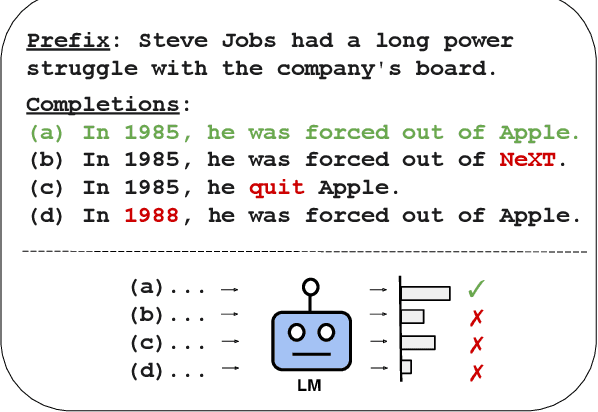
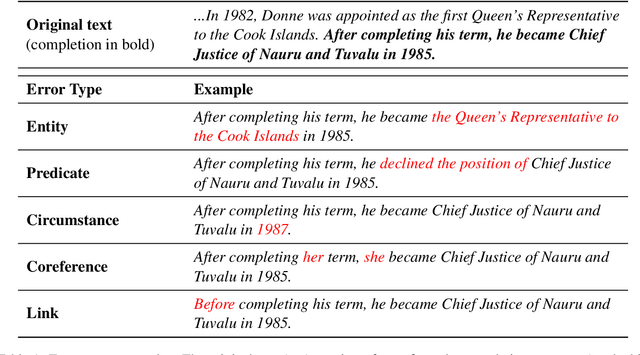
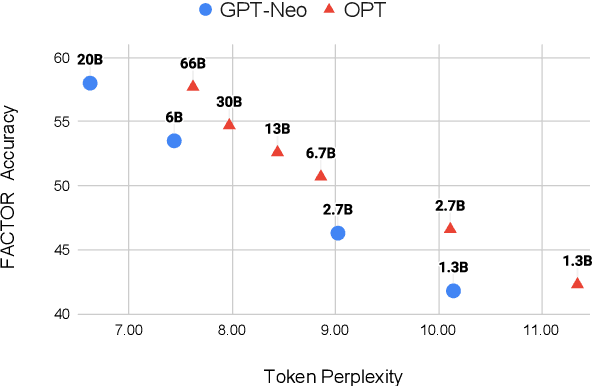
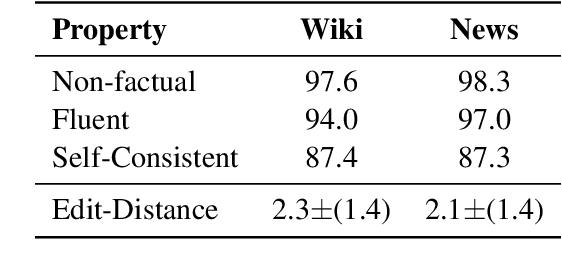
Abstract:Before deploying a language model (LM) within a given domain, it is important to measure its tendency to generate factually incorrect information in that domain. Existing factual generation evaluation methods focus on facts sampled from the LM itself, and thus do not control the set of evaluated facts and might under-represent rare and unlikely facts. We propose FACTOR: Factual Assessment via Corpus TransfORmation, a scalable approach for evaluating LM factuality. FACTOR automatically transforms a factual corpus of interest into a benchmark evaluating an LM's propensity to generate true facts from the corpus vs. similar but incorrect statements. We use our framework to create two benchmarks: Wiki-FACTOR and News-FACTOR. We show that: (i) our benchmark scores increase with model size and improve when the LM is augmented with retrieval; (ii) benchmark score correlates with perplexity, but the two metrics do not always agree on model ranking; and (iii) when perplexity and benchmark score disagree, the latter better reflects factuality in open-ended generation, as measured by human annotators. We make our data and code publicly available in https://github.com/AI21Labs/factor.
In-Context Retrieval-Augmented Language Models
Jan 31, 2023Abstract:Retrieval-Augmented Language Modeling (RALM) methods, that condition a language model (LM) on relevant documents from a grounding corpus during generation, have been shown to significantly improve language modeling while also providing a natural source attribution mechanism. Existing RALM approaches focus on modifying the LM architecture in order to facilitate the incorporation of external information, significantly complicating deployment. This paper proposes an under-explored alternative, which we dub In-Context RALM: leaving the LM architecture unchanged and prepending grounding documents to the input. We show that in-context RALM which uses off-the-shelf general purpose retrievers provides surprisingly large LM gains across model sizes and diverse corpora. We also demonstrate that the document retrieval and ranking mechanism can be specialized to the RALM setting to further boost performance. We conclude that in-context RALM has considerable potential to increase the prevalence of LM grounding, particularly in settings where a pretrained LM must be used without modification or even via API access. To that end, we make our code publicly available.
Parallel Context Windows Improve In-Context Learning of Large Language Models
Dec 21, 2022Abstract:For applications that require processing large amounts of text at inference time, Large Language Models (LLMs) are handicapped by their limited context windows, which are typically 2048 tokens. In-context learning, an emergent phenomenon in LLMs in sizes above a certain parameter threshold, constitutes one significant example because it can only leverage training examples that fit into the context window. Existing efforts to address the context window limitation involve training specialized architectures, which tend to be smaller than the sizes in which in-context learning manifests due to the memory footprint of processing long texts. We present Parallel Context Windows (PCW), a method that alleviates the context window restriction for any off-the-shelf LLM without further training. The key to the approach is to carve a long context into chunks (``windows'') that fit within the architecture, restrict the attention mechanism to apply only within each window, and re-use the positional embeddings among the windows. We test the PCW approach on in-context learning with models that range in size between 750 million and 178 billion parameters, and show substantial improvements for tasks with diverse input and output spaces. Our results motivate further investigation of Parallel Context Windows as a method for applying off-the-shelf LLMs in other settings that require long text sequences.
What Are You Token About? Dense Retrieval as Distributions Over the Vocabulary
Dec 20, 2022



Abstract:Dual encoders are now the dominant architecture for dense retrieval. Yet, we have little understanding of how they represent text, and why this leads to good performance. In this work, we shed light on this question via distributions over the vocabulary. We propose to interpret the vector representations produced by dual encoders by projecting them into the model's vocabulary space. We show that the resulting distributions over vocabulary tokens are intuitive and contain rich semantic information. We find that this view can explain some of the failure cases of dense retrievers. For example, the inability of models to handle tail entities can be explained via a tendency of the token distributions to forget some of the tokens of those entities. We leverage this insight and propose a simple way to enrich query and passage representations with lexical information at inference time, and show that this significantly improves performance compared to the original model in out-of-domain settings.
Standing on the Shoulders of Giant Frozen Language Models
Apr 21, 2022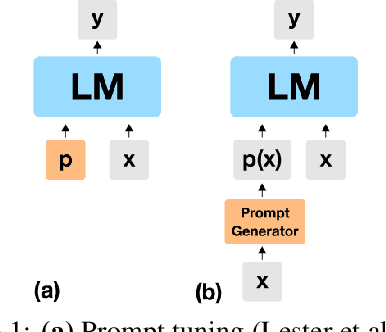
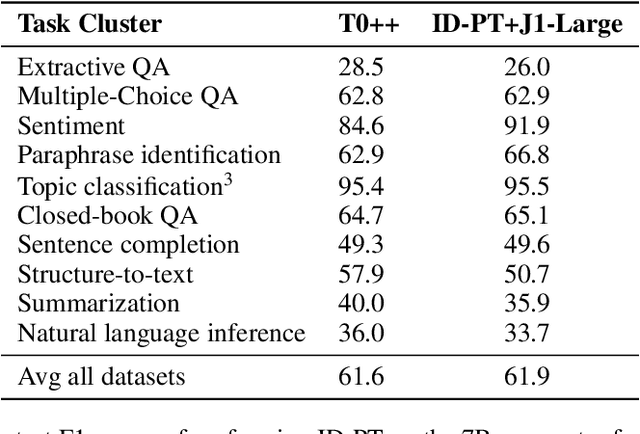
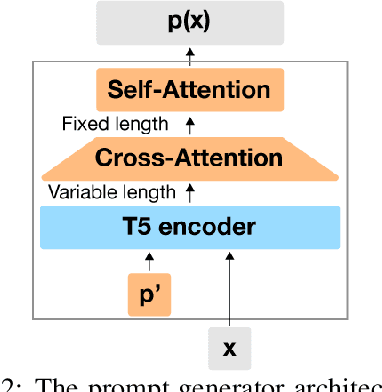

Abstract:Huge pretrained language models (LMs) have demonstrated surprisingly good zero-shot capabilities on a wide variety of tasks. This gives rise to the appealing vision of a single, versatile model with a wide range of functionalities across disparate applications. However, current leading techniques for leveraging a "frozen" LM -- i.e., leaving its weights untouched -- still often underperform fine-tuning approaches which modify these weights in a task-dependent way. Those, in turn, suffer forgetfulness and compromise versatility, suggesting a tradeoff between performance and versatility. The main message of this paper is that current frozen-model techniques such as prompt tuning are only the tip of the iceberg, and more powerful methods for leveraging frozen LMs can do just as well as fine tuning in challenging domains without sacrificing the underlying model's versatility. To demonstrate this, we introduce three novel methods for leveraging frozen models: input-dependent prompt tuning, frozen readers, and recursive LMs, each of which vastly improves on current frozen-model approaches. Indeed, some of our methods even outperform fine-tuning approaches in domains currently dominated by the latter. The computational cost of each method is higher than that of existing frozen model methods, but still negligible relative to a single pass through a huge frozen LM. Each of these methods constitutes a meaningful contribution in its own right, but by presenting these contributions together we aim to convince the reader of a broader message that goes beyond the details of any given method: that frozen models have untapped potential and that fine-tuning is often unnecessary.
Transformer Language Models without Positional Encodings Still Learn Positional Information
Mar 30, 2022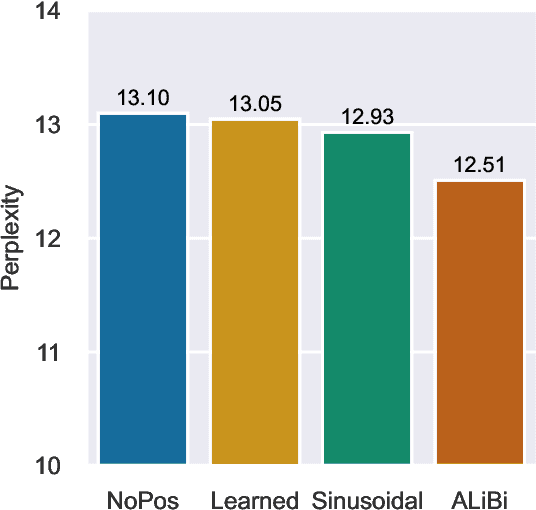
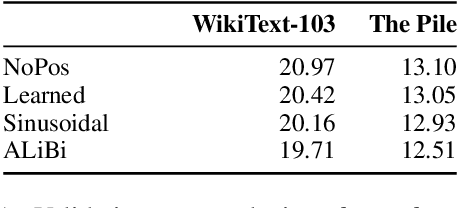
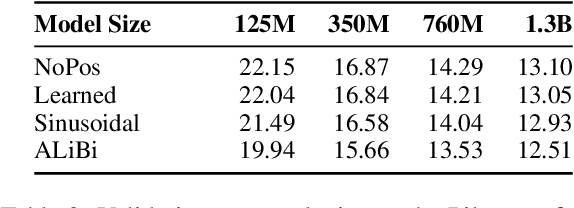
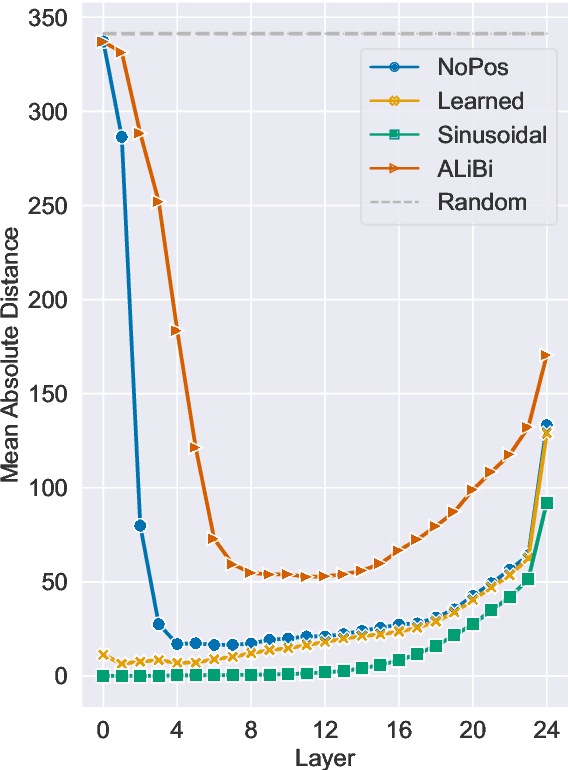
Abstract:Transformers typically require some form of positional encoding, such as positional embeddings, to process natural language sequences. Surprisingly, we find that transformer language models without any explicit positional encoding are still competitive with standard models, and that this phenomenon is robust across different datasets, model sizes, and sequence lengths. Probing experiments reveal that such models acquire an implicit notion of absolute positions throughout the network, effectively compensating for the missing information. We conjecture that causal attention enables the model to infer the number of predecessors that each token can attend to, thereby approximating its absolute position.
Learning to Retrieve Passages without Supervision
Dec 14, 2021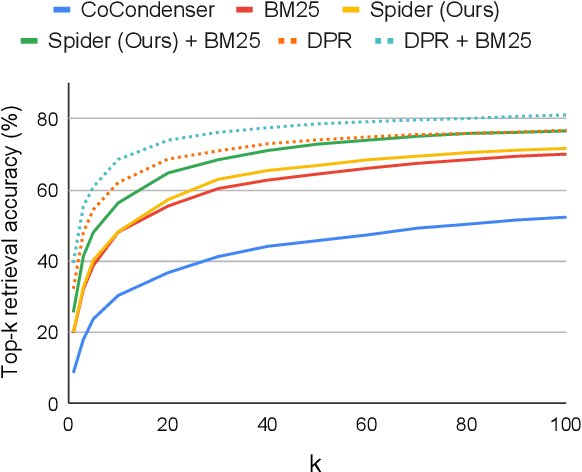
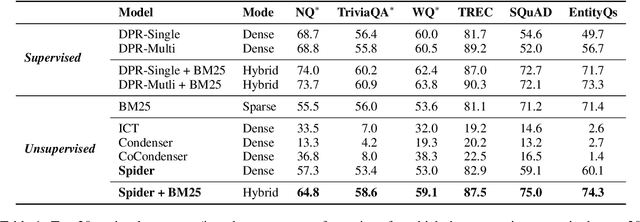

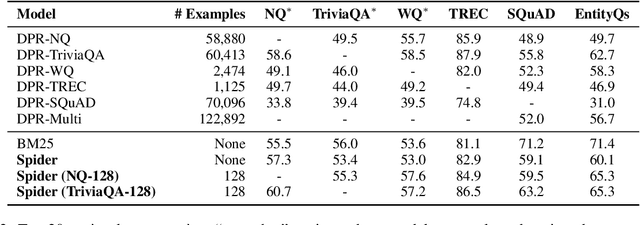
Abstract:Dense retrievers for open-domain question answering (ODQA) have been shown to achieve impressive performance by training on large datasets of question-passage pairs. We investigate whether dense retrievers can be learned in a self-supervised fashion, and applied effectively without any annotations. We observe that existing pretrained models for retrieval struggle in this scenario, and propose a new pretraining scheme designed for retrieval: recurring span retrieval. We use recurring spans across passages in a document to create pseudo examples for contrastive learning. The resulting model -- Spider -- performs surprisingly well without any examples on a wide range of ODQA datasets, and is competitive with BM25, a strong sparse baseline. In addition, Spider often outperforms strong baselines like DPR trained on Natural Questions, when evaluated on questions from other datasets. Our hybrid retriever, which combines Spider with BM25, improves over its components across all datasets, and is often competitive with in-domain DPR models, which are trained on tens of thousands of examples.
How Optimal is Greedy Decoding for Extractive Question Answering?
Aug 12, 2021



Abstract:Fine-tuned language models use greedy decoding to answer reading comprehension questions with relative success. However, this approach does not ensure that the answer is a span in the given passage, nor does it guarantee that it is the most probable one. Does greedy decoding actually perform worse than an algorithm that does adhere to these properties? To study the performance and optimality of greedy decoding, we present exact-extract, a decoding algorithm that efficiently finds the most probable answer span in the context. We compare the performance of T5 with both decoding algorithms on zero-shot and few-shot extractive question answering. When no training examples are available, exact-extract significantly outperforms greedy decoding. However, greedy decoding quickly converges towards the performance of exact-extract with the introduction of a few training examples, becoming more extractive and increasingly likelier to generate the most probable span as the training set grows. We also show that self-supervised training can bias the model towards extractive behavior, increasing performance in the zero-shot setting without resorting to annotated examples. Overall, our results suggest that pretrained language models are so good at adapting to extractive question answering, that it is often enough to fine-tune on a small training set for the greedy algorithm to emulate the optimal decoding strategy.
Few-Shot Question Answering by Pretraining Span Selection
Jan 02, 2021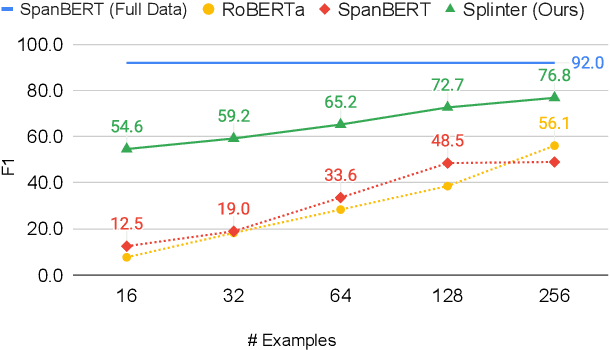
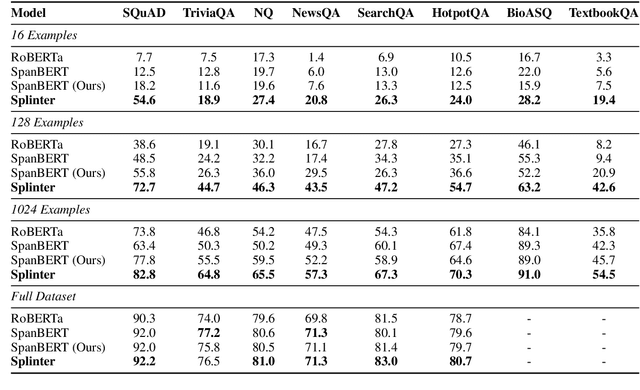

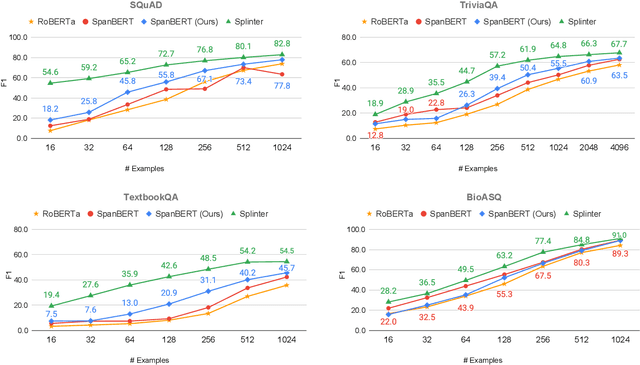
Abstract:In a number of question answering (QA) benchmarks, pretrained models have reached human parity through fine-tuning on an order of 100,000 annotated questions and answers. We explore the more realistic few-shot setting, where only a few hundred training examples are available. We show that standard span selection models perform poorly, highlighting the fact that current pretraining objective are far removed from question answering. To address this, we propose a new pretraining scheme that is more suitable for extractive question answering. Given a passage with multiple sets of recurring spans, we mask in each set all recurring spans but one, and ask the model to select the correct span in the passage for each masked span. Masked spans are replaced with a special token, viewed as a question representation, that is later used during fine-tuning to select the answer span. The resulting model obtains surprisingly good results on multiple benchmarks, e.g., 72.7 F1 with only 128 examples on SQuAD, while maintaining competitive (and sometimes better) performance in the high-resource setting. Our findings indicate that careful design of pretraining schemes and model architecture can have a dramatic effect on performance in the few-shot settings.
 Add to Chrome
Add to Chrome Add to Firefox
Add to Firefox Add to Edge
Add to Edge